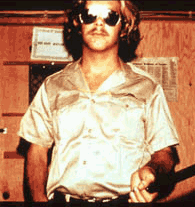The first one I will share with you is the Stanford Prison Experiment of 1971.
This involved a two week investigation into how people reacted being placed in different roles, in this case, prisoners and prison guards. Subjects consisted of healthy young males.
(Subjects had previously answered a newspaper article wanting volunteers for a psychological experiment).
Out of the subjects involved, half of them were randomly assigned as "prisoners", and were (without knowledge or warning) suddenly arrested from outside their homes on a quiet Sunday morning in California. They were finger-printed, locked in cells and blindfolded.
A simulated prison was eradicated, into which the "prisoners" were placed.
The other half of the subjects took on the role of "prison guards" and adopted uniforms and dark glasses.
Ex-convicts were consulted throughout the experiment to ensure that prison life was realistic to their experiences.
There was "The Yard" which was the only place (except the toilet) where "prisoners" could exercise.
"The Hole" was used for solitary confinement, and was a small closet, about 2 feet wide and 2 feet deep.
There were no windows or clocks, therefore a lot of the "prisoners" experienced serious time-distorting experiences.
On arrival from the police cells, the "prisoners" were reminded of how serious their "crimes" were and were told they would be imprisoned.
Each "prisoner" was stripped naked, "de-loused", and had their heads shaved (the degradation procedure). Imagine how humiliating this would be!
Each "prisoner" had to wear a plain smock dress, with their "prison number" on the front, with no underwear, and a chain around their right ankle at all times. The chain was an important part of the experiment, as it would constantly remind the "prisoners" of the oppressive environment they are in, and even during the night, whenever they turned in their beds, the chain would wake them and make sleep difficult.
The "prisoners" were called by their prison ID numbers and never by their names.
The "guards" were not given any training on how to "be" a guard, they were left free to act how they pleased towards the "prisoners" in order to maintain sufficient order. They were allowed to make up their own set of rules. Below is what one of the guards looked like - they all wore identical uniforms and mirrored sunglasses, to prevent the "prisoners" from seeing into their eyes or reading any emotion.
There were 9 "guards" and 9 "prisoners". The "guards" worked 8 hour shifts on a rota system, with more on stand by of they were needed.
At 2.30am the "prisoners" were awakened suddenly by whistles for a body count. These were to allow "prisoners" to become familiar with their individual prison ID number, but also to allow both sets of subjects to "feel out" their roles, and settle into them, by providing an opportunity for communication.
One of the punishments the guards adopted were push-ups, To the experimenters, this initially seemed like an inappropriate and juvenile way to punish someone, until they found out that push-ups were commonly used as punishment in Nazi concentration camps. One guard even chose to stand on a prisoner's back during push-ups, or make the "prisoners" stand on each other.
A rebellion ensued, the next morning. The prisoners ripped off their prison ID numbers and barricaded themselves in the cells with the beds up against the doors. The guards were furious about this, and the "prisoners" began to taunt and curse them.
The guards took fire extinguishers and fired freezing cold carbon dioxide at the prisoners to make them stay away from the doors. They then stripped the prisoners naked, forced the ringleaders into solitary confinement and began to humiliate and abuse the prisoners.
The guards decided to set up a "privilege cell", where the 3 prisoners who were least involved in the rebellion were allowed to have their uniforms and beds back, and eat special food in front of the other prisoners, who had temporarily lost the privilege of eating.
The guards stopped allowing the prisoners to go to the toilet when they wished, and after lights out at 10pm, many prisoners had to go to the toilet in a bucket in their cell. The guards even banned the prisoners from emptying these buckets, and the cells soon filled with stench.
After 36 hours, one of the prisoners #8612 became acutely emotionally disturbed, disorganised thinking, uncontrollable crying and overcome by rage. Below is a photo of prisoner #8612. He had to be released due to severe mental disturbance. Another prisoner developed a psychosomatic rash all over his body from the stress of the prison environment. By this point the study was pretty much over, as it became apparent that the experiment had moulded some very disturbed individuals, as the guards became sadistic and the prisoners acted like hospitalised mental patients.
It is interesting to note that no guard ever missed a shift, turned up late, called in sick or demanded extra pay.
I hope you have found this information interesting, I will make the second post of this nature very soon!
If you want a much more detailed account of the above experiment, please visit this site here.


